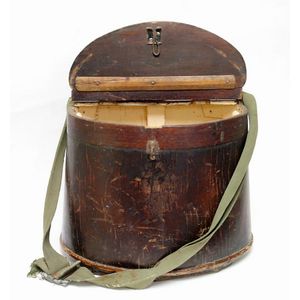Tibetan Iron Container with Etched Gilding
You must be a subscriber, and be logged in to view price and dealer details.
Subscribe Now to view actual auction price for this item
When you subscribe, you have the option of setting the currency in which to display prices to $Au, $US, $NZ or Stg.
- Gilding - Gilding is a method of ornamentation whereby a thin sheet of gold metal is applied to items made of wood, leather, ceramics, glass and silver for decorative purposes.
For furniture including mirrors, the sheet of gold is usually applied over a coating of gesso. Gesso is a mixture of plaster of Paris and gypsum mixed with water and then applied to the carved wooden frames of mirrors and picture frames as a base for applying the gold leaf. After numerous coats of gesso have been applied, allowed to dry and then sanded a coat of "bole", a usually red coloured mixture of clay and glue is brushed on and allowed to dry, after which the gold leaf is applied. Over time parts of the gilding will rub off so the base colour can be seen. In water gilding, this was generally a blue colour, while in oil gilding, the under layer was often yellow. In Victorian times, gilders frequently used red as a pigment beneath the gold leaf.
Metal was often gilded by a process known as fire gilding. Gold mixed with mercury was applied and heated, causing the mercury to evaporate, the long-term effect of which was to kill or disable the craftsman or woman from mercury poisoning. The pursuit of beauty has claimed many victims, not the least of which were the artists who made those pieces so highly sought after today.
This item has been included into following indexes:
Visually similar items

An unusual vintage English kidney shaped wooden fishing creel, traditional cream interior, metal closing latch to lid, complete with canvas carry strap. 33 cm x 19 cm x 30 cm

Pair of bronze jardinieres, Chinese, of squat globular form, each with twin applied foo dog heads. Height 35 cm. Diameter 49 cm

Jeff Mincham (b. 1950) ceramic pot earthernware raku vessel, applied fin like decoration to top surface, inscribed artist's signature 'Mincham 88' to base (A/F). Height 21 cm. Diameter 34 cm

A Chinese bronze censer, 20th century, with lion head handles & a six character impressed Ming mark to base. Height 6.5 cm, diameter 13 cm
